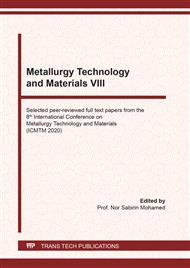[1]
Y.Z. Li, N. Mangelinck-Noël, G. Zimmermann and L. Sturz, Comparative study of directional solidification of Al-7 wt.% Si alloys in space and on earth: effects of gravity on dendrite growth and columnar to equiaxed transition, J. Cryst. Growth, 513(2019) 20-29.
DOI: 10.1016/j.jcrysgro.2019.02.050
Google Scholar
[2]
H. Jung, N. Mangelinck-Noël, H. Nguyen-Thi and B.Billia, Columnar to equiaxed transition during directional solidification in refined Al-based alloys, J. Alloys Compd., 484(2009) 739-746.
DOI: 10.1016/j.jallcom.2009.05.029
Google Scholar
[3]
G.Reinhart, Ch.-A. Gandin, N. Mangelinck-Noël, H. Nguyen-Thi, J.-E. Spinelli, J. Baruchel, and B. Billia, Influence of natural convection during upward directional solidification: a comparison between in situ X-ray radiography and direct simulation of the grain structure, Acta Mater., 61(2013) 4765-4777.
DOI: 10.1016/j.actamat.2013.04.067
Google Scholar
[4]
M.A. Martorano, V.B. Biscuola, Predicting the columnar-to-equiaxed transition for a distribution of nucleation undercoolings, Acta Mater., 57(2009) 607-615.
DOI: 10.1016/j.actamat.2008.10.001
Google Scholar
[5]
P. Nie, O.A. Ojo and Z. Li, Numerical modeling of microstructure evolution during laser additive manufacturing of a nickel-based superalloy, Acta Mater., 77 (2014) 85-95.
DOI: 10.1016/j.actamat.2014.05.039
Google Scholar
[6]
W. Wang, Z. Wang, S. Yin, L. Sen and M. Zhu,Numerical simulation of solute undercooling influenced columnar to equiaxed transition of Fe-C alloy with cellular automaton, Comput. Mater. Sci, 167(2019) 52-64.
DOI: 10.1016/j.commatsci.2019.05.027
Google Scholar
[7]
R. Lenart, M. Eshraghi, Modeling columnar to equiaxed transition in directional solidification of Inconel 718 alloy, Comput. Mater. Sci, 172 (2020) 109374.
DOI: 10.1016/j.commatsci.2019.109374
Google Scholar
[8]
Z.J. Wang, S. Luo, H.W. Song, W.D. Deng and W.Y. Li, Simulation of microstructure during laser rapid forming solidification based on cellular automaton, Math. Probl. Eng. 2014 (2014) 627528.
DOI: 10.1155/2014/627528
Google Scholar
[9]
R. Chen, Q.Y. Xu, B.C. Liu, Simulation of the dendrite morphology and microsegregation in solidification of Al-Cu-Mg aluminum alloys, Acta Metall. Sin., 28(2) (2015) 173-181.
DOI: 10.1007/s40195-014-0183-7
Google Scholar
[10]
L. Nastac, D.M. Stefanescu, Stochastic modelling of microstructure formation in solidification processes, Modell. Simul. Mater. Sci. Eng., 5(4) (1997) 391-420.
DOI: 10.1088/0965-0393/5/4/008
Google Scholar


